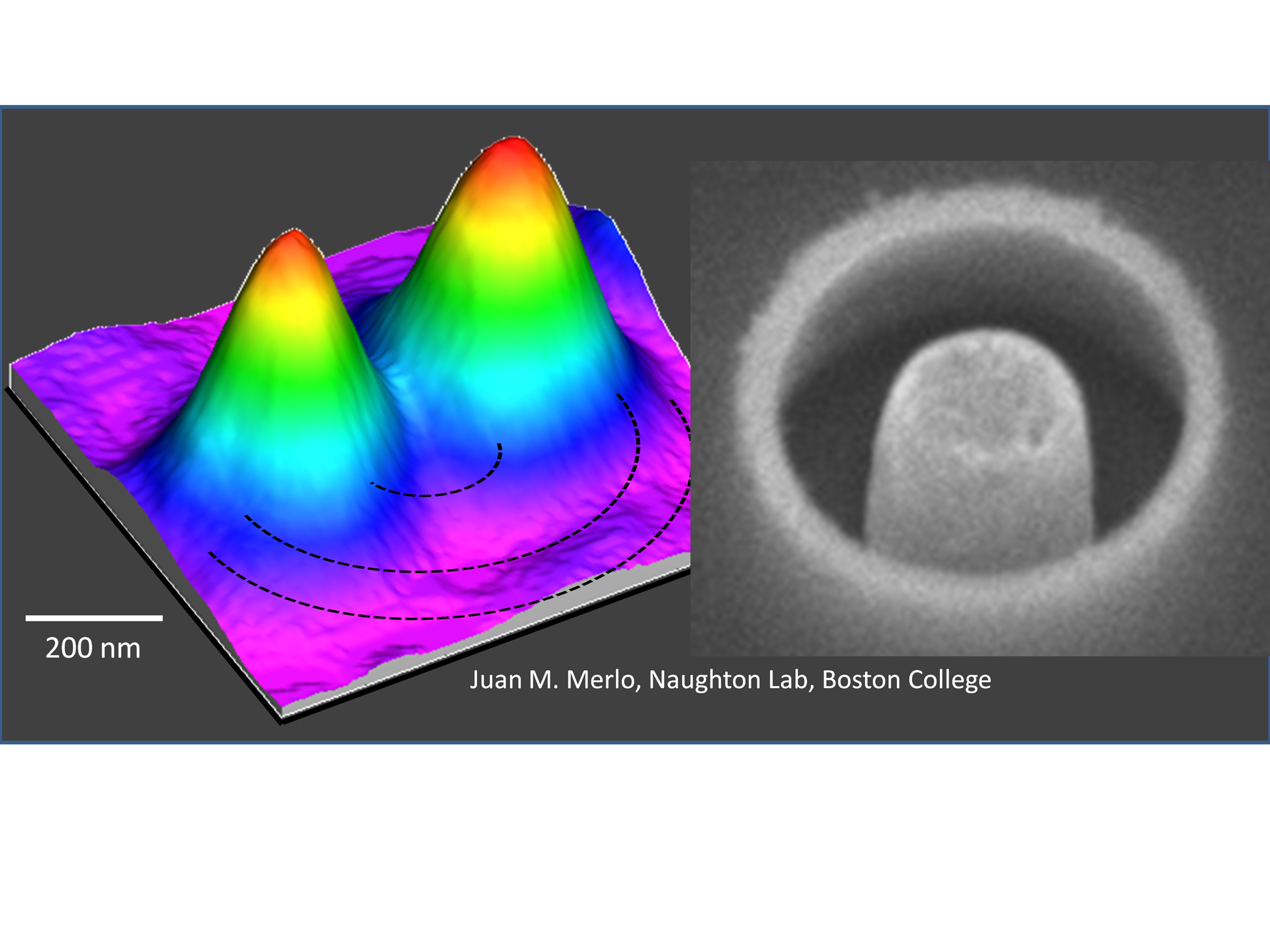Join NESM for our annual Spring Meeting on Thursday, February 25th at Boston College! The meeting will consist of facility tours, two technical talks and a buffet dinner. We look forward to seeing you there!
Meeting Schedule
5:00 PM - Registration & Facility Tours
6:00 PM - Dinner
6:50 PM - Welcome
7:00 PM - "Nanoscale Coaxial Probes with Optical, Solar and Sensing Utility", Michael J. Naughton, Boston College
7:35 PM - "Stimulated Raman Scattering Microscopy: Label-free Vibrational Imaging for Biology and Medicine", Sunney Xie, Harvard University
8:10 PM - Closing
Speaker Abstracts & Bios
"Nanoscale Coaxial Probes with Optical, Solar and Sensing Utility", Michael J. Naughton, Boston College

Image Details: SEM image of a single nanocoax (right) and contour of optical intensity of 532 nm polarized light propagating along and out the coax (left), as measured by leakage radiation microscopy.
Abstract:
We discuss a nanoscale coaxial architecture with potential utility in nanophotonics, photovoltaics, visual prosthetics, and biological, chemical and neuro sensing. As subwavelength optical waveguides, these nanostructures can be used in a range of nanoscale manipulations of light, including optical nanoscopy and lithography, high efficiency solar cells, high electrode-density retinal implants and discrete optical metamedia. A modification of the basic structure enables the fabrication of highly sensitive molecular sensors and high resolution optoelectronic neurostimulators/sensors (optrodes). We will report on aspects of these applications, including bio, electrochemical and neuroelectronic sensing. Work done in collaboration with T.C. Chiles, J.P. Christianson, K. Kempa, M.J. Burns, T. Connolly, J.M. Merlo, J. Varela, Y. Calm, J.R. Naughton, A. Rose, M.M. Archibald, B. Rizal, and others.
Bio
Michael J. Naughton is Evelyn J. and Robert A. Ferris Professor in the Department of Physics at Boston College. He received a B.S. in Physics from St. John Fisher College, a Ph.D. from Boston University, and did a postdoc at the University of Pennsylvania. He was a faculty member at SUNY Buffalo for ten years. Since 1998, he has been at Boston College, serving as chairman of the Physics Department since 2006 after spending an interim year as Vice President for Research. Naughton is an NSF Young Investigator Awardee (back when he was young) and a Fellow of the American Physical Society. A condensed matter experimentalist, Naughton’s research is on electrical, optical and magnetic properties of low dimensional and nanoscale matter, including nanostructured bio/chemical and neuroelectronic sensors, solar cells, near-field optics and plasmonics, and molecular organic superconductors. He has patents in micro- and nanoscale magnetometry, plastic landmine detection, and nanocoaxial electrodes for microscopy, photovoltaics and sensing. He cofounded Tau Sensors LLC and Solasta Inc., and serves on the technical advisory boards of Bloo Solar and NBD Nano.
"Stimulated Raman Scattering Microscopy: Label-free Vibrational Imaging for Biology and Medicine", Sunney Xie, PhD.Harvard University
Abstract:
Stimulated Raman scattering (SRS) microscopy is a label-free and non-invasive imaging technique using vibration spectroscopy as the contrast mechanism. Recent advances have allowed significant improvements in sensitivity, selectivity, robustness, and cost reduction, opening a wide range of applications. This is particularly relevant in biology since SRS microscopy does not affect cell function, and is best suited for imaging small metabolite molecules. For medicine, SRS microscopy provides non-invasive and instant tissue examination without the need of previous histological staining procedures.
Bio:
Xiaoliang Sunney Xie received a B.S. from Peking University in 1984, and his Ph.D. from the University of California at San Diego in 1990, followed by a short postdoctoral experience at the University of Chicago. In 1992, Xie joined Pacific Northwest National Laboratory, where he later became a Chief Scientist. In 1999, he was appointed Professor of Chemistry at Harvard University. He is currently the Mallinckrodt Professor of Chemistry and Chemical Biology at Harvard, and the Cheung Kong Visiting Professor at Peking University, and the Director of Biodynamics Optical Imaging Center (BIOPIC). Xie is among the first to conduct fluorescence studies of single molecules at room temperature in the early 1990s. He has made major contributions to the emergence of the field of single-‐molecule biophysical chemistry and its application to biology. His team also pioneered the development of coherent Raman scattering microscopy and single cell whole genome sequencing. His honors include the Albany Prize in Medicine and Biomedical Research, the U. S. Department of Energy E. O. Lawrence Award, the Biophysical Society’s Founders Award, the National Institute of Health Director’s Pioneer Award, the Sackler Prize for Physical Sciences and the American Chemical Society’s Peter Debye Award. Xie is a fellow of the American Academy of Arts and Sciences and a member of the National Academy of Sciences. He is also an honorary fellow of the Chinese Chemical Society and has received scholarly awards from China, Germany and Israel.
Location
Boston College, Higgins Hall, 2nd floor atrium (#2 below)
140 Commonwealth Ave, Boston, MA 02467
Directions
-By public transportation: The MBTA Green Line B branch to Boston College stops at the entrance at 140 Commonwealth Ave (see map below).
-By car: For easiest access, use the entrance at 140 Commonwealth Ave and follow St. Thomas Moore Rd. to the Commonwealth Parking Garage (#1 in map below).
.jpg)
Parking
Parking garage, $3/hour